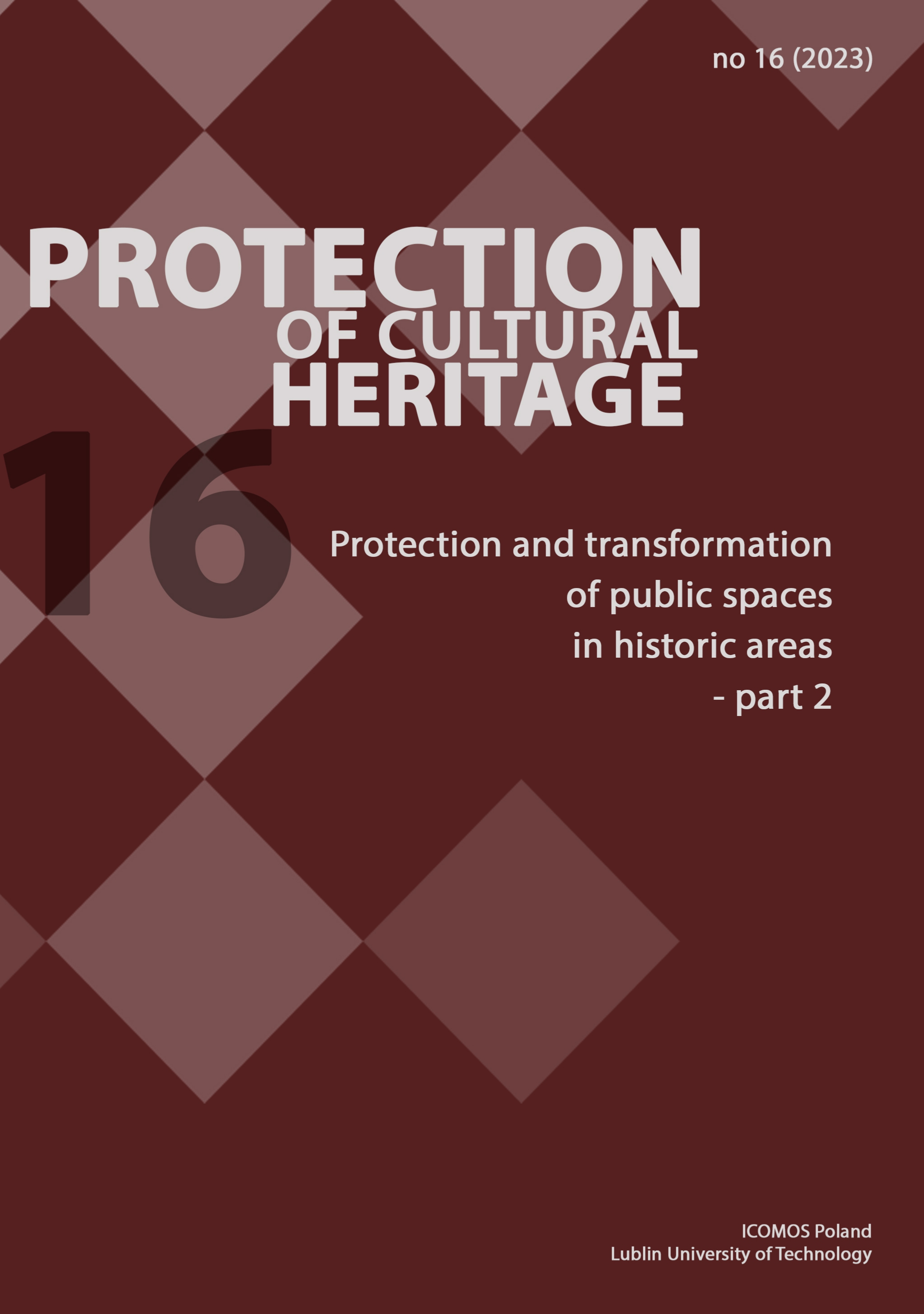The heart of public interventions in historic cities: reflections on the HRIDAY scheme
Article Sidebar
Open full text
Issue No. 16 (2023)
-
Contemporary revitalization of public spaces in Łódź. The role of squares, streets and courtyards in creating the genius loci based on the historical heritage
Łukasz Mikołaj Sadowski, Aleksandra Sumorok7-20
-
Towards a nature-culture relationship in historic centres. Evidence of public spaces beyond tourism in Florence (Italy)
Corinna Del Bianco21-34
-
From Beneficiation Haciendas to Heritage Public Spaces in the City of Guanajuato. Plaza de los Ángeles Case
Enya Cerca Cervantes, Velia Yolanda Ordaz Zubia35-43
-
Figure and ground: an English view of the conservation of historic public spaces
Nigel Walter45-58
-
Intangible values and touristification of public spaces in the ancient centre of Naples (Italy)
Rita Gagliardi59-71
-
The heart of public interventions in historic cities: reflections on the HRIDAY scheme
Swapna Kothari, Shivangi Thakur75-85
-
Courtyards of castles partially reconstructed in historic towns
Kamila Boguszewska, Katarzyna Drobek87-109
Main Article Content
DOI
Authors
Abstract
This article discusses two specific implementations from the Heritage City Development and Augmentation Yojana, also known as the HRIDAY scheme in India, specifically how they address public spaces in historical cities. HRIDAY (2014-2019) was formulated to provide holistic development and improve infrastructure, mainly in pilgrim towns, under the Ministry of Urban Development, now the Ministry of Housing and Urban Affairs (MoHUA). The scheme took into consideration the complexity of dealing with entire historic cities. This is especially challenging for local urban bodies focused primarily on the core of a city, i.e. its historic centre. The goal was to revitalise the city’s unique character by “encouraging the development of an aesthetically appealing, accessible, informative and secure environment” (MOUD 2015). However, while the scheme ended, there are still many historic towns and cities across the country that could benefit from reflections and insights from already executed projects. To undertake any further development in line with the scheme, it is imperative to understand its application, specifically in terms of public space typology. HRIDAY primarily addressed the need to foster cultural identity by improving public infrastructure and promoting tourism. The article addresses how public chowks (squares) and market streets benefited from the scheme, basing on secondary sources about two selected cities. Discussion covers additions of sanitation and public conveniences, development of venues for cultural events in existing public space and interventions such as creation of interpretation centres and improvement of paths. These analyses serve as the basis for the formulation of guidelines and theories that could inform future heritage development in sensitive urban spaces in cities and towns across India.
Keywords:
References
Architectural Heritage Division (2011). Heritage City Development-plan of Varanasi, New Delhi: INTACH
Architectural Heritage Division (2016). Preparation of City HRIDAY Plan Including Civic Infrastructure Development Plan for Varanasi, New Delhi: INTAH
Celebrating Indian Public Spaces. Gupta, A., & Gupta, A. (2017). Celebrating Public Spaces of India, first ed. Ahmedabad: Mapin Publishing
CRCI (India) Pvt. Ltd. & IPE Global Pvt. Ltd. (2016). City HRIDAY Plan for Amritsar (Vol. I, II, III, IV, V), first ed. Municipal Corporation of Punjab
Desai, J., Joshi, R., Rai, G. (2017). HRIDAY reflections- A Monograph on the Heritage City Development and Augmentation Yojana, first ed. Ahmedabad: CEPT University, ICOMOS India
Ministry of Urban Development. (2015). Guidelines for HRIDAY, New Delhi: Ministry of Urban Development. https://mohua.gov.in/upload/uploadfiles/files/GuidelinesHRIDAY.pdf
National Institute for Urban Affairs. (2016). Heritage City Development and Augmentation Yojana, second ed. New Delhi: Ministry of Urban Development. https://smartnet.niua.org/content/7663306a-7610-46a0-919f-d0688d9493e8
Article Details
Abstract views: 269
License

This work is licensed under a Creative Commons Attribution-ShareAlike 4.0 International License.






